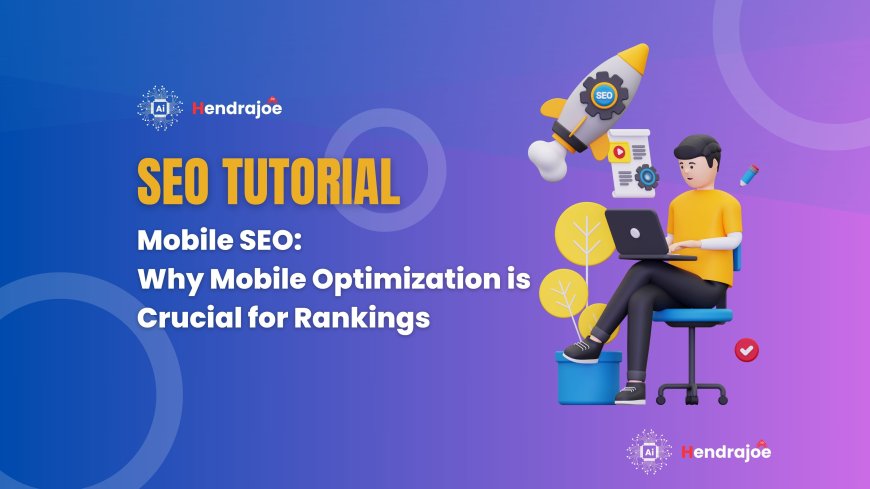Mobile SEO: Why Mobile Optimization is Crucial for Rankings
Learn why mobile optimization is essential for SEO rankings. Discover how to make your website mobile-friendly with design, speed, and content optimization tips

In today’s digital world, mobile devices are at the center of how users access the internet. Whether it’s browsing social media, shopping online, or simply searching for information, mobile devices have become the primary way people interact with the web. As a result, mobile SEO has become more important than ever for ensuring your website is visible and ranks well in search engine results.
In this article, we’ll explore why mobile optimization is crucial for rankings, the factors that affect mobile SEO, and the steps you can take to ensure your website is mobile-friendly and optimized for search engines.
1. What is Mobile SEO?
Mobile SEO refers to the process of optimizing your website to ensure it performs well on mobile devices, such as smartphones and tablets. Since mobile users are a significant portion of web traffic, search engines, especially Google, have made mobile-friendliness a top ranking factor.
Google’s mobile-first indexing means that Google predominantly uses the mobile version of a webpage's content for ranking and indexing purposes. This shift was implemented because more users now search the web using mobile devices than desktops, making mobile optimization critical for visibility and rankings.
2. Why is Mobile Optimization Important for Rankings?
1. Google's Mobile-First Indexing
In 2018, Google announced mobile-first indexing, meaning that Googlebot, the search engine's crawler, will prioritize the mobile version of a website for indexing and ranking. Previously, Google used the desktop version of a site to rank pages. Now, if your site is not mobile-friendly, it could negatively impact your search rankings.
Mobile-first indexing means that search engines look at how well your website performs on mobile devices, including its design, content, and load time, rather than just its desktop version. If your mobile site is slow, difficult to navigate, or lacks valuable content, it may result in a lower ranking in search results.
2. Mobile Traffic is Increasing
The number of mobile users has been steadily increasing over the past decade. According to recent statistics, more than half of all global web traffic now comes from mobile devices. This shift in user behavior means that if your website is not optimized for mobile, you could be missing out on a significant portion of potential traffic.
Even if your desktop version performs well in search rankings, a poor mobile experience can cause users to bounce from your site, leading to lower engagement metrics and a negative impact on your rankings. Mobile optimization helps you cater to a larger audience, improving your visibility and performance in search engines.
3. Improved User Experience and Engagement
Google’s algorithm considers user experience (UX) as a ranking factor. A website that is mobile-optimized is not only easier to navigate but also improves the overall experience for visitors. When users have a positive experience on your site, they’re more likely to stay longer, browse more pages, and even convert—whether that means making a purchase, signing up for a newsletter, or contacting you.
Conversely, a site that is difficult to navigate on mobile—due to slow loading times, unresponsive design, or poor layout—will lead to a high bounce rate. A high bounce rate signals to Google that your site is not providing value, which can negatively affect your SEO rankings.
4. Voice Search and Mobile Search Behavior
As mobile technology evolves, more users are relying on voice search. Devices like smartphones and voice assistants (like Google Assistant, Siri, and Alexa) have made voice search a regular part of everyday life. Since voice searches tend to be more conversational and often longer, optimizing your site for mobile is essential to cater to this growing trend.
Moreover, mobile users typically engage in local searches more frequently. Google’s local search algorithm takes mobile optimization into account when ranking websites for location-based queries. Having a mobile-friendly site ensures that users searching for businesses in their area are more likely to find your site.
3. Factors That Impact Mobile SEO
To improve your mobile SEO and rank higher in search results, you need to focus on several key factors:
1. Mobile-Friendly Website Design
A mobile-friendly design ensures that your website’s content adjusts and displays correctly across different screen sizes. Whether a user is visiting your site on a smartphone, tablet, or desktop, your website should provide an optimal viewing experience.
Here are some key elements of a mobile-friendly design:
- Responsive Web Design: A responsive design adapts to various screen sizes and devices automatically. This is the preferred method for mobile optimization because it provides a seamless experience for users across all devices.
- Touchscreen Compatibility: Ensure buttons, links, and other interactive elements are large enough to be tapped easily on small screens. Avoid tiny text and difficult navigation elements.
- Readable Content: Content should be readable without the need for zooming. This includes having a font size that is easy to read on smaller devices.
2. Mobile Page Speed
Page speed is an important ranking factor for both desktop and mobile versions of your site. Mobile users often experience slower internet connections compared to desktop users, so optimizing your website’s speed is crucial for keeping visitors engaged.
You can improve your mobile page speed by:
- Compressing images and files.
- Minimizing JavaScript and CSS.
- Using browser caching to reduce load time.
- Leveraging content delivery networks (CDNs) for faster loading speeds.
3. Mobile-Friendly Navigation
On mobile devices, screen space is limited, which means navigation needs to be simplified. Ensure your menu and other navigational elements are easy to find and use on mobile devices. Implement a hamburger menu or sticky navigation bars for easy access to important pages without overwhelming the user with options.
4. Avoid Pop-Ups and Interstitials
Pop-ups and interstitials (large ads or content that obstructs the page) are particularly disruptive on mobile devices. Google has made it clear that intrusive interstitials and pop-ups on mobile pages can negatively impact rankings. While pop-ups are sometimes necessary, make sure they don’t hinder the user experience or make the site difficult to navigate.
5. Optimize Content for Mobile
Content that’s optimized for mobile devices should be easy to read and scroll through. Use shorter paragraphs, concise headings, and properly sized images to ensure that users don’t have to zoom or scroll excessively to read your content. Remember that mobile users typically skim content, so using bullet points and short sentences can enhance readability.
6. Local SEO for Mobile
Since mobile users often conduct local searches, optimizing for local SEO is essential. Ensure that your business’s location is listed correctly on Google My Business and that your NAP (Name, Address, and Phone Number) is consistent across all directories and pages. Additionally, make sure your mobile site is easy to navigate for users searching for local businesses.
4. How to Improve Your Mobile SEO
Here are several actionable steps you can take to optimize your website for mobile:
1. Test Mobile-Friendliness Using Google’s Mobile-Friendly Test Tool
Google offers a free Mobile-Friendly Test Tool that allows you to check whether your website is mobile-friendly. Simply enter your URL, and the tool will analyze your website and give you feedback on any issues that need attention.
2. Use Google Search Console to Monitor Mobile Usability
Google Search Console provides a Mobile Usability Report that shows you which pages on your website may have mobile-related issues. You can use this report to identify problems with page speed, navigation, or content display and fix them to improve your mobile SEO.
3. Focus on AMP (Accelerated Mobile Pages)
AMP is an open-source framework that enables faster loading times for mobile users. By creating simplified, fast-loading pages using AMP, you can improve both the user experience and your rankings. However, be aware that AMP may not be necessary for every site, and it should be implemented strategically.
4. Keep Your Design Simple and Focused
Mobile users often have limited time and attention spans. By keeping your design clean and minimal, you improve usability and make it easier for visitors to find what they need. Avoid unnecessary clutter and focus on providing a clear and straightforward path to your content.
5. Conclusion
Mobile SEO is no longer optional—it’s essential. With Google’s mobile-first indexing, the growing prevalence of mobile traffic, and the shift in how users interact with websites, optimizing your site for mobile is crucial for maintaining and improving your rankings.
By focusing on mobile-friendly design, fast loading speeds, intuitive navigation, and high-quality content that’s easy to read on small screens, you can ensure that your website is optimized for mobile users and search engines alike. Start optimizing your site for mobile today to improve user experience, boost rankings, and drive more traffic.
What's Your Reaction?








































